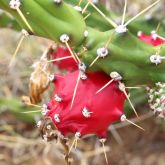Harrisia cactus

Harrisia cactus fruit, stem and spike
© Queensland Government

Harrisia cactus plant form without fruit
© Queensland Government

Harrisia cactus plant form
© Queensland Government

Harrisia cactus inside of the fruit
© Queensland Government

Harrisia cactus mealy bug
© Queensland Government

Harrisia cactus full plant form
© Queensland Government

Harrisia cactus flower
© Queensland Government
Native to South America, harrisia cactus is a spiny perennial plant. Harrisia cactus was introduced to Queensland as a pot plant in the 1890s and is now found in a number of sites across the state. It can infest pastures and reduce them to a level unsuitable for stock.
You must manage the impacts of Harrisia cactus on your land.
You must not give away, sell or release Harrisia cactus into the environment.
All species of Harrisia (syn. Eriocereus) are prohibited invasive plants except for H. martinii, H. tortuosa and H. pomanensis syn. Cereus pomanensis, which are restricted invasive plants under the Biosecurity Act 2014.
Scientific name
Other names
- Moonlight cactus, snake cactus
Description
- Spiny perennial plant with fleshy-jointed stems that form tangled mats about 0.5m tall.
- Stems are ribbed lengthwise with 6 ribs.
- Ribs have low, thick, triangular humps at regular intervals.
- Humps have cushions of grey felty hairs, 3–5 short spines lying flat, and 1–3 erect, stiff, sharp spines 2.5–3cm long.
- Flowers are large, funnel-shaped, pink with tinge of white.
- Flowers grow singly on slender, scaly, grey-green tube 12–15cm long.
- Fruit is round, 4–5cm across, bright red, with scattered bumps, hairs and spines.
- Seeds are small, black, embedded in fruit's white, juicy pulp.
- Shallow feeding roots are up to 3cm thick and 30cm–2m long, growing mostly horizontally off a crown, up to 15cm below ground level.
- Swollen tuberous storage roots descend 15−60cm.
Habitat
- Occurs in brigalow and associated softwood country.
- Infestations also found in eucalypt and pine forests.
- Tolerates shade and reaches maximum development in shade and shelter of brigalow scrub, though established infestations can persist once scrub is pulled.
Distribution
- Visit the Weeds Australia website and click on the distribution tab to access the distribution map.
Life cycle
- Bears bright red fruit containing 400–1000 small black seeds. Fruit and seed are readily eaten by birds and to a lesser extent by feral pigs. Plants are easily established from seed dropped by these animals. Seeds germinate soon after rain.
- Seedlings quickly produce swollen tuberous food storage root that develops as plant grows. Branches take root where they touch ground, and new plants will grow from broken branches and sections of underground tubers.
- Counts of tubers in dense cactus infestations have shown more than 125,000 per hectare. Each plant houses many dormant underground buds that are all capable of reshooting when tip growth dies; any small portion of tuberous root left in soil will grow.
Impacts
Economic
- Forms dense infestations that choke out other pasture species when left unchecked.
- Spines interfere with stock mustering and movement, and cause injuries and lameness.
How it is spread
- Fruit spread by birds and animals.
Prevention
Control
Mechanical control
- Dig out plants completely and burn. Ensure all tubers are removed and destroyed.
- Plough only if followed by annual cropping.
Herbicide control
- Herbicides can be effective.
Read the harrisia cactus fact sheet (PDF, 4.5MB) for herbicide control and application rates.
Biological control
Two introduced insects have become established:
- a stem-boring longicorn beetle (Alcidion cereicola)
- a mealybug (Hypogeococcus festerianus).
Stem-boring beetle only attacks older woody stems. In Collinsville area, large beetle colonies developed and contributed to collapse of dense areas of cactus. Populations of Alcidion cereicola have declined with reduction in cactus in recent years. More successful biological control agent is mealybug Hypogeococcus festerianus, which is now present in most areas infested with harrisia cactus. Mealybug is considered more effective in more northern areas of Central Queensland.
Legal requirements
All species of Harrisia (syn. Eriocereus) are prohibited invasive plants except for H. martinii, H. tortuosa and H. pomanensis syn. Cereus pomanensis, which are restricted invasive plants under the Biosecurity Act 2014.
Prohibited
- Harrisia (syn. Eriocereus) is a prohibited invasive plant under the Biosecurity Act 2014.
- You must not keep, move, give away, sell or release into the environment. Penalties may apply.
- You must not take any action reasonably likely to exacerbate the biosecurity threat posed by Harrisia (syn. Eriocereus). Penalties may apply.
- You must take any action that is reasonably likely to minimise the biosecurity threat posed by Harrisia (syn. Eriocereus).
- The Act requires all sightings to be reported to Biosecurity Queensland within 24 hours.
Restricted
- Harrisia cactus is a category 3 restricted invasive plant under the Biosecurity Act 2014.
- You must not give away, sell, or release into the environment. Penalties may apply.
- You must take all reasonable and practical measures to minimise the biosecurity risks associated with dealing with harrisia cactus under your control. This is called a general biosecurity obligation (GBO).
- At a local level, each local council must have a biosecurity plan that covers invasive plants and animals in its area. This plan may include actions to be taken on harrisia cactus. Some of these actions may be required under local laws. Contact your local council for more information.